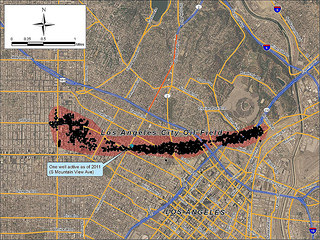Oil Drilling increases Population in Los Angeles
In 1865, seven years after Edwin Drake developed the first oil drilling system in North America—located in Pennsylvania—Union Matolle Company moved into California’s Central Valley, east of San Francisco. Union Matolle Company hoped to replicate the success of the Pennsylvania drillings and find large amounts of oil in Northern California. During this period, California’s population increased by approximately 375% in the years following the 1849 gold rush, and California’s demand for oil was increasing dramatically. However, Union Matolle failed to find sufficient oil supplies. The company could not produce the oil to keep up with consumer demand. As a result, Californians found themselves in desperate need of oil.
Meanwhile, in 1892, Edward L. Doheny, a gold prospector, and his partner, Charles A. Canfield, discovered an abundance of oil in Southern California. When word spread about Doheny and Canfields discoveries, drilling companies flocked to Southern California. By 1894, 80 wells were producing oil in the Los Angeles area; by 1897, the number of wells had bourgeoned to over 500. This created a lot of jobs opportunities in Los Angeles, and the population grew from 50,395 in1890 to 102,479 in 1900, according to the US Census Bureau.
The discovery of oil in California had a significant impact on the price of oil—both in the state of California and across America. In 1860, 0.5 million barrels of oil were produced throughout the country. By 1895, the state of California, alone, produced 1.2 million barrels of oil. With the new oil supplies from California—along with increased oil production in Texas and Pennsylvania—the price decreased from $9.60 per barrel in 1860 to $0.25 per barrel in 1895.
American oil companies including Union Oil Company became concerned with this development because oil prices had fallen too low for oil companies to maintain high profit margins. Union Oil Company and other oil companies lobbied local and federal governments to regulate the overproduction in the oil market. Their attempts, however, were futile and no regulation was passed. Oil prices remained around $1 through the end of the 19th century.
At the turn of the century, oil production in California continued to rise at a booming rate. In 1900, the state of California produced 4 million barrels. In 1920, production had expanded to 77 million barrels. Between 1920 and 1930, new oil fields across Southern California were being discovered with regularity including Huntington Beach in 1920, Long Beach and Santa Fe Springs in 1921, and Dominguez in 1923. Southern California had become the hotbed for oil production in the United States. In a 1926 Times magazine article, it was said, “[The Standard Oil Company of California] is the largest individual producer of crude oil in the U.S. and dominates the marketing of petroleum products along the west coast of both Americas.” During this same period, California’s agriculture and manufacturing markets were also expanding rapidly, and the increased oil production helped to power the development of these industries.
Even today, oil production is active in Los Angeles, even as close as 2 miles away from Azusa Street. The image on the left shows active oil production sites in downtown Los Angeles.


